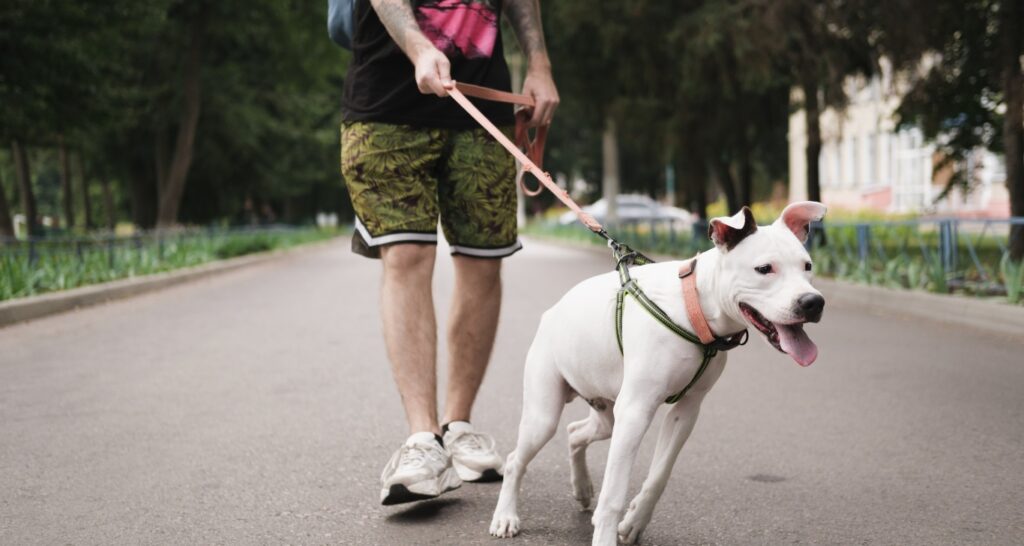Whether dog should be put on a collar in public places or not depends on the legal regulation of your area, safety requirements and individual dog’s requirements. So, Do dogs need to wear a collar in public? This article seeks to establish why this is so, the other options that are available to dog owners, and the Right way to go about it. Explore the best dog collars for walking that offer comfort, durability, and control, making every walk enjoyable and safe for both you and your dog.
Blog Highlights
ToggleWhat Are Legal Requirements for Dog Collars in the US?
In the United States, there are no set rules on whether or not dogs must wear a collar when in public and this depends on the state and city. Normally, many countries have put laws that require the owners of dogs to ensure that the dogs wear collars with identification tags while in public places so as to protect the dogs and facilitate the recovery of lost pets.

1. General Requirements for Dog Collars in the U.S.
Some of the states have laws that require dogs to be harnessed with a collar and ID tag in the course of a day. It has a hole where one can fix a leash and this assists the owners to control their dogs particularly in areas with high human and vehicle traffic.
Also, the ID tag may have the name of the dog, the owner’s name, address and phone number, thus increasing the chances of finding the owner if the dog gets lost. These regulations ensure safety of the public and responsible pet ownership since the owners are made to answer for their pets’ behaviors.
Some states have statutes that address collars and others do not, and instead, leave it for the cities and towns to decide. Hence it is important to note that requirements might vary greatly based on the location.
For instance, while in Michigan, Pennsylvania, and Tennessee the best form of control for a dog is to ensure that it is always on control and this means that the dog has to be on a leash, the collar with identification is also very important in such states. Find out whether a harness or collar is better for dog walking, considering factors like safety, control, and comfort for both you and your pet.
2. Leash and Collar Laws by State
Several types of leash laws exist across different states in the U. S., which indirectly emphasize the importance of collars:

- Leash Required at All Times: While some states have leash laws, which make it a legal requirement for dog owners to restrain their pets when they are not on the owner’s property, some of these states include; Michigan, Pennsylvania, and Tennessee.
- Running at Large: Most of the states have laws that ban dogs from wandering or roaming freely without the owner’s control. Such laws may be general to the state or may be left to the specific cities and towns. Some of the states which have such laws include Texas, Florida, New York and California among others.
- Leashes in Specific Areas: Some of the states have set some restrictions about leashes especially in certain regions such as parks, wildlife regions and state regions. For instance, while statewide leash laws in California are quite lax, most towns within the state has more rigid leash laws especially in the parks and other social areas.
3. Special Regulations and Exemptions
There are some exceptions to these rules based on the type of breed of the dog; more often than not, leash and collar rules are universal for all dogs. However, some states have what is known as breed specific legislation (BSL) which have other rules for the certain breeds that are considered dangerous for example, a dog has to be muzzled.
In addition, specific rules may apply to particular situations:
- Rabies Quarantine: If there is rabies quarantine then dogs should be on a leash and should not leave the premises of its owner.
- Leashing Female Dogs in Heat: Some of the states have laws that bar females dogs on heat from wandering in the streets and must be on a leash at all times.
4. Penalties for Non-Compliance
Those who do not follow leash and collar laws are likely to face some consequences which may be in form of a fine, a warning or even a jail term where the offense is severe. Normally, the first offenders are only given a warning, but in the case of continued violation or very serious violation, one may be fined anything from $25 to $500 or even more.
In some jurisdictions, there are other consequences whereby the owner is required to take the dog through some sort of training or perform some community service. In the extreme, a dog can be impounded until the owner has paid all the required penalties. Understand why a Great Dane can make an excellent family dog with insights into their temperament and adaptability.
5. Local Variations and Importance of Compliance
Because the leash and collar laws are routinely set on the local level, it is advisable for the owners of the dogs to contact the local authorities, or the There are some regions which allow the owners to let their dogs off the leash but such places are rather exceptional. It is mandatory to follow these laws or else face legal consequences as well as protect the well-being of both the dogs and public.
What Are Legal Requirements for Dog Collars in the UK?
Many cities and towns have laws that mandate that dogs should be dressed with a collar which has identification when in public domain. For instance, the Control of Dogs Order 1992 in the UK requires that all dogs in public places should be tagged with owner’s name and address through a collar.

This is a requirement that has to be obeyed even if the dog is not on a leash. There are some exceptions like guide dogs, Search and Rescue dogs, sport hunting and sport tracking dogs and dogs for assistance in police or military work.
Likewise, in most of the U.S. states, dogs are made to wear collars with identification tags when in the public places. This makes a surety that in case a dog is found, then it can be easily recognized and taken back to the owner.
Nevertheless, a collar is still useful in the initial identification since anyone can read it as opposed to the microchip which needs scanning equipment and a database to access it.
If these laws are broken, then one can be fined or in extreme cases one can be jailed. Hence, one must ensure that they get to know the various legal requirements that have been put in place within their locality to prevent them from being penalized. Get prepared with helpful advice on bringing home a Great Dane puppy, including essential preparations and training tips.
What Are the Alternatives to Dog Collars?
Collars are very useful in identification of the dogs however there are other forms of collars such as harnesses which could be more comfortable for some dogs. Harnesses also help to distribute the pressure all over the dog’s body especially if the dog has breathing difficulties or has a neck injury. Still, if the dog is harnessed, the law may still mandate him or her to wear a collar complete with ID tags.
Some dog owners also use what is called “tag collars,” which are light weight collars that are used to hold identification tags. This option can give the identification that is required without the size or inconvenience of a standard collar. But it is important that the tags should be firmly fixed in place in order not to get detached easily.
Microchipping vs. Collars
Another form of identification is the micro chipping which is mandatory in many countries including the UK. In the UK, it has been mandatory for all dogs to be microchipped since 6th of April, 2016 and this has to be done before the dog is eight weeks old.

Though microchipping will offer the particular identification which can not be changed in any way, it does not exclude the use of collar. A microchip has to be scanned to recover the details while a collar with an ID tag is easily accessible to anyone who may find the dog. Learn whether it’s safe for a dog to swim with an e-collar, including safety tips and recommendations.
When to Put a Collar on Your Dog?
So, Do dogs need to wear a collar in public? Although it is the law to have dogs wear collars in public, there are instances that it is beneficial or necessary to remove the collar from the dog especially when at home or when confined in a crate. It can help avoid skin rash and skin irritation as well as the collar can get caught and lead to choking hazard at times.

It is also suitable to dismantle the collar during the periods of playing with other dogs and within the close observation to avoid some injuries. But for one to venture into any public area, he/she should ensure that the collar is on and well adjusted in place. Check out the best options for dog collars for Great Danes that offer both strength and comfort for these large breeds.
Best Practices for Using Dog Collars
Here are some tips for using collars effectively:
- Check Fit Regularly: Check that the collar is comfortable and does not chock you, you should be able to fit two fingers between the collar and your neck. These should be altered depending with the size and age of the puppy especially for the growing ones.
- Keep ID Tags Up to Date: Also ensure that the ID tags are well Fastened and the information on the ID tags is clean and the contact details are up to date. You should also provide your name, the address you are currently staying at and a phone contact.
- Consider a Breakaway Collar: For extra measure, especially for the dogs left alone, breakaway collar is useful in avoiding choking if the collar is stuck.
- Remove During Inappropriate Situations: Only unfasten the collar when you placed your dog in a crate, when it is at night or when it is playing with other canines to avoid mishaps.
Wrap Up!
Whenever dogs are taken out in public, they should be made to wear collars for the purpose of the law as well as safety. There are other options including harnesses and tag collars however these do not meet the legal proviso that is in place in many places. It is therefore important for owners to abide with the law by making sure that their dogs are fitted with collars and tags to enhance the identification of the dogs.
This will keep your dog safe and also to make sure you do not fall on the wrong side of the law. Hope so, now you know, do dogs need to wear a collar in public? Discover the top picks for dog collars suitable for swimming that are designed to handle water exposure while keeping your pet comfortable.





